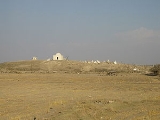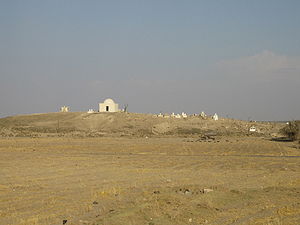
Tell el Fakhariya
Encyclopedia
Tell el Fakhariya, or Tell el Fecheriyeh with variants, is an ancient site in the Khabur River
basin in the Al Hasakah Governorate of northern Syria
. In the area several mounds called can be found in close proximity: Tell el Fakhariya, Ra's al-'Ayn
, and Tell Halaf
; the Aramean and Neo-Assyria
n city of Guzana.
It has been suggested as the site of Washukanni
, the capital of Mitanni
.
period. The limited excavations so far conducted have shown
substantial developments in the Middle Assyrian, Mitanni
and
Neo-Assyrian periods
as the Hurrian capital of Mitanni, Washukanni.
The name Sikan was then believed to be an Assyrianized version of its Hurrian, or Indo-Aryan original, becoming (Wa-)Sikan(-ni). This etymology is challenged by Edward Lipiński on the grounds that the word sikan can simply mean stele
.
No epigraphic, glyphic or other archaeological evidence supporting
this identification has yet emerged from excavations at
this or other sites. The identification thus rests on a purely etymologic basis.
Washukanni, or Waššukanni (also spelled Washshukanni, Wassuganni, Vasukhani, or variants) was the capital of the Hurrian kingdom of Mitanni from c.1500 BC. Washukanni flourished as a capital city for two centuries. The city is known to have been sacked by the Hittites
under Suppiluliumas I (ruled ca. 1358 - 1323 BC). whose treaty inscription relates that he installed a Hurrian vassal king, Shattiwaza
. The city was sacked again by the Assyria
n king Adad-nirari I
around 1290, but very little else is known of its history.
 The site is around 90 hectares in area, 12 of which are a high mound. Tell Fakhariyah came to the attention of Max von Oppenheim
The site is around 90 hectares in area, 12 of which are a high mound. Tell Fakhariyah came to the attention of Max von Oppenheim
in the early 1900s. In 1929, during his excavations at Tell Halaf, he dispatched Felix Langenegger and Hans Lehmann to the site to do a field survey, resulting in the production of a contour map.
. In 1940, a team from the Oriental Institute of Chicago and the Boston Museum of Fine Arts, led by Calvin W. McEwan, and which included Harold D. Hill, worked for a short period there, conducted several soundings, developed a contour map of the site, and collected various pottery and epigraphic objects.
The later included 12 tablets and some fragments. The areas explored were mainly Middle Assyrian
and Neo-Assyrian. In 1955, Anton Moortgat
conducted two soundings at Tell Fakhariyah, dated to the Mitanni empire period.
A brief excavation occurred in 2001 by the University of Halle-Wittenberg
and the Syrian Directorate-General of Antiquities and Museums
.
After a survey in 2005, a team from the Free University of Berlin
and SAHI - Slovak archeological and historical institute and the Syrian Directorate-General of Antiquities and Museums resumed work at Tell Fakhariyah for a month in 2006. Excavations continued in 2007 for a period of 8 weeks.
In the 2009 season, 11 Middle Assyrian cuneiform tablets
were recovered from a layer early in the post-Mitanni period
of the site. In 2010, 40 texts and text fragments were found
in the same context. Preliminary translation shows them to be
administrative in nature. Eponyms link some to the reigns
of Shalmaneser I and Tukulti-Ninurta I.
Khabur River
The Khabur River , , , ) is the largest perennial tributary to the Euphrates in Syrian territory. Although the Khabur originates in Turkey, the karstic springs around Ra's al-'Ayn are the river's main source of water. Several important wadis join the Khabur north of Al-Hasakah, together creating...
basin in the Al Hasakah Governorate of northern Syria
Syria
Syria , officially the Syrian Arab Republic , is a country in Western Asia, bordering Lebanon and the Mediterranean Sea to the West, Turkey to the north, Iraq to the east, Jordan to the south, and Israel to the southwest....
. In the area several mounds called can be found in close proximity: Tell el Fakhariya, Ra's al-'Ayn
Ra's al-'Ayn
Ra's al-'Ayn is a Syrian city administratively belonging to Al-Hasakah Governorate. Ra's al-'Ayn has an altitude of 360 m. It has a population of 55,247, many of them being Assyrian/Syriacs, Arabs, Kurds, Armenians, Chechens, or Syrian Turkmen. There is a border crossing to Ceylanpınar in Turkey...
, and Tell Halaf
Tell Halaf
Tell Halaf is an archaeological site in the Al Hasakah governorate of northeastern Syria, near the Turkish border, just opposite Ceylanpınar. It was the first find of a Neolithic culture, subsequently dubbed the Halaf culture, characterized by glazed pottery painted with geometric and animal designs...
; the Aramean and Neo-Assyria
Assyria
Assyria was a Semitic Akkadian kingdom, extant as a nation state from the mid–23rd century BC to 608 BC centred on the Upper Tigris river, in northern Mesopotamia , that came to rule regional empires a number of times through history. It was named for its original capital, the ancient city of Assur...
n city of Guzana.
It has been suggested as the site of Washukanni
Washukanni
Washukanni was the capital of the Hurrian kingdom of Mitanni, from c. 1500 BC to the 13th century BC. Its precise location is unknown, but it is widely thought to have existed on one of the tributaries of the Khabur River. Some scholars believe it is identical with the later, ancient city of Sikan...
, the capital of Mitanni
Mitanni
Mitanni or Hanigalbat was a loosely organized Hurrian-speaking state in northern Syria and south-east Anatolia from ca. 1500 BC–1300 BC...
.
History
The site of Tell el Fakhariya was occupied as early as the Akkadianperiod. The limited excavations so far conducted have shown
substantial developments in the Middle Assyrian, Mitanni
Mitanni
Mitanni or Hanigalbat was a loosely organized Hurrian-speaking state in northern Syria and south-east Anatolia from ca. 1500 BC–1300 BC...
and
Neo-Assyrian periods
Proposed association with Washukanni
The Neo-Assyrian city of Sikan at nearby Ra's al-'Ayn was identified by Dietrich OpitzDietrich Opitz
Dietrich Opitz was a German assyriologist and colleague of Bruno Meissner. He was the first to propose that Tell el Fakhariya was the location of Wassuganni, capital of the Hurrian kingdom of Mitanni from c.1500 BC. though this is now considered unlikely....
as the Hurrian capital of Mitanni, Washukanni.
The name Sikan was then believed to be an Assyrianized version of its Hurrian, or Indo-Aryan original, becoming (Wa-)Sikan(-ni). This etymology is challenged by Edward Lipiński on the grounds that the word sikan can simply mean stele
Stele
A stele , also stela , is a stone or wooden slab, generally taller than it is wide, erected for funerals or commemorative purposes, most usually decorated with the names and titles of the deceased or living — inscribed, carved in relief , or painted onto the slab...
.
No epigraphic, glyphic or other archaeological evidence supporting
this identification has yet emerged from excavations at
this or other sites. The identification thus rests on a purely etymologic basis.
Washukanni, or Waššukanni (also spelled Washshukanni, Wassuganni, Vasukhani, or variants) was the capital of the Hurrian kingdom of Mitanni from c.1500 BC. Washukanni flourished as a capital city for two centuries. The city is known to have been sacked by the Hittites
Hittites
The Hittites were a Bronze Age people of Anatolia.They established a kingdom centered at Hattusa in north-central Anatolia c. the 18th century BC. The Hittite empire reached its height c...
under Suppiluliumas I (ruled ca. 1358 - 1323 BC). whose treaty inscription relates that he installed a Hurrian vassal king, Shattiwaza
Shattiwaza
Shattiwaza , was a king of the Hurrian kingdom of Mitanni in the fourteenth century BC.Shattiwaza was the brother of king Tushratta. His Hurrian name was Kili-Tešup. In the political turmoil following the death of his predecessor, the usurper Shuttarna tried to murder Shattiwaza...
. The city was sacked again by the Assyria
Assyria
Assyria was a Semitic Akkadian kingdom, extant as a nation state from the mid–23rd century BC to 608 BC centred on the Upper Tigris river, in northern Mesopotamia , that came to rule regional empires a number of times through history. It was named for its original capital, the ancient city of Assur...
n king Adad-nirari I
Adad-nirari I
Adad-nirari I was a king of Assyria. He is the earliest Assyrian king whose annals survive in any detail. Adad-nirari I achieved major military victories that significantly strengthened the Assyrian kingdom and enabled Assyria to start to play a major role in Mesopotamian politics...
around 1290, but very little else is known of its history.
Archaeology

Max von Oppenheim
Max Freiherr von Oppenheim was a German ancient historian, and archaeologist, "the last of the great amateur archaeological explorers of the Near East."....
in the early 1900s. In 1929, during his excavations at Tell Halaf, he dispatched Felix Langenegger and Hans Lehmann to the site to do a field survey, resulting in the production of a contour map.
. In 1940, a team from the Oriental Institute of Chicago and the Boston Museum of Fine Arts, led by Calvin W. McEwan, and which included Harold D. Hill, worked for a short period there, conducted several soundings, developed a contour map of the site, and collected various pottery and epigraphic objects.
The later included 12 tablets and some fragments. The areas explored were mainly Middle Assyrian
Middle Assyrian
Middle Assyrian refers to the Middle Assyrian period of the Ancient Near East, ca. 16th to 10th centuries BC *the Middle Assyrian Empire, see Assyrian Empire*the Middle Assyrian language, see Akkadian language...
and Neo-Assyrian. In 1955, Anton Moortgat
Anton Moortgat
Anton Moortgat was a Belgian archaeologist. He was the first full professor for the archaeology of the ancient near east in Germany.- Biography :...
conducted two soundings at Tell Fakhariyah, dated to the Mitanni empire period.
A brief excavation occurred in 2001 by the University of Halle-Wittenberg
University of Halle-Wittenberg
The Martin Luther University of Halle-Wittenberg , also referred to as MLU, is a public, research-oriented university in the cities of Halle and Wittenberg within Saxony-Anhalt, Germany...
and the Syrian Directorate-General of Antiquities and Museums
Directorate-General of Antiquities and Museums
The Directorate-General for Antiquities and Museums is a Syrian government directorate responsible for the protection, promotion and excavation activities in all sites of national heritage in Syria. The directorate was established shortly after Syria's independence in 1946...
.
After a survey in 2005, a team from the Free University of Berlin
Free University of Berlin
Freie Universität Berlin is one of the leading and most prestigious research universities in Germany and continental Europe. It distinguishes itself through its modern and international character. It is the largest of the four universities in Berlin. Research at the university is focused on the...
and SAHI - Slovak archeological and historical institute and the Syrian Directorate-General of Antiquities and Museums resumed work at Tell Fakhariyah for a month in 2006. Excavations continued in 2007 for a period of 8 weeks.
In the 2009 season, 11 Middle Assyrian cuneiform tablets
were recovered from a layer early in the post-Mitanni period
of the site. In 2010, 40 texts and text fragments were found
in the same context. Preliminary translation shows them to be
administrative in nature. Eponyms link some to the reigns
of Shalmaneser I and Tukulti-Ninurta I.

